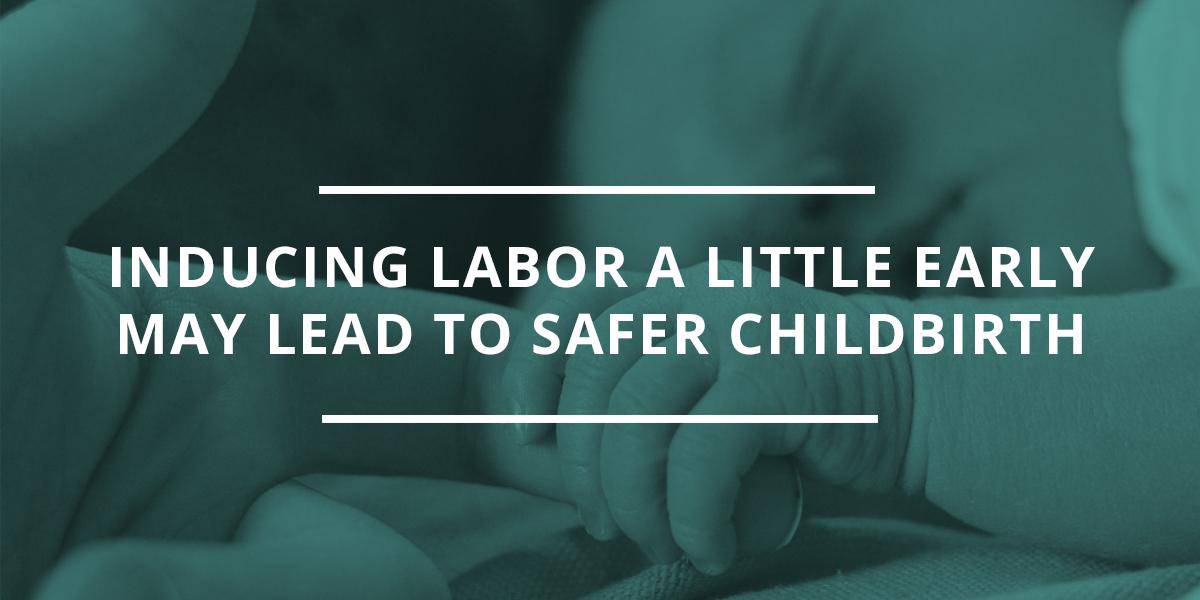
Labor induction, or inducing labor, is when a health care provider will give a pregnant woman medicine or use other methods to stimulate uterine contractions before labor begins, and potentially break the amniotic sac to start labor a little earlier than the woman’s natural pregnancy progression. Any healthcare provider may recommend inducing labor for a whole array of reasons, but it has been a rule of thumb that women are not offered the option of inducing labor until after their fortieth week of pregnancy.
What Does the NIH Say?
A recent study by the National Institutes of Health (NIH) has stated that inducing labor a week before a mother’s due date could dramatically decrease complication risks and ultimately lead to safer deliveries. The study found that mothers who induced labor during week thirty-nine, as opposed to waiting for their labor to naturally begin, were much less likely to require C-sections. These induced labors also saw lower rates of preeclampsia and other labor complications.
The NIH study also found that inducing labor in the thirty-ninth week didn’t increase chances of stillbirth and other very severe birth injuries, as compared to mothers who weren’t induced at all. There’s no doubt about it that this NIH study is pivotal in terms of how all of us view the latter stages of pregnancies, and the New England Journal of Medicine has also recently stated how labor induction might change how we view child delivery.
It’s been a preconceived notion throughout the medical industry that early induction of labor can lead to a higher chance of emergency cesarean delivery, which is why almost all doctors wouldn’t want to induce before the fortieth week. But there wasn’t any type of comprehensive research done to support this “rule of thumb” until NIH funded this recent study involving over 6,000 healthy, first-time expecting mothers who voluntarily enrolled.
What essentially happened during the NIH study was half of the expecting mothers had their labor induced during their thirty-ninth week and the other half began labor completely naturally. The study found that the mothers who induced in the thirty-ninth week of pregnancy saw lower rates of emergency C-sections and lower rates of maternal blood pressure conditions.
Medical Reasons for Inducing Labor
A healthcare provider will always evaluate several factors when determining if labor induction is necessary, including the mother’s and baby’s overall health, the baby’s weight and size, the baby’s gestational age, the position of the baby in the uterus and the general status of the mother’s cervix.
Other reasons for labor induction include the following:
- Post-term Pregnancy: This is when an expecting mother goes beyond two weeks of her due date with labor not naturally beginning.
- Premature membrane rupture: When your water breaks, but labor still hasn’t started.
- Chorioamnioitis: A uterus infection
- Restrictions in fetal growth: This situation typically requires an induced labor when a baby is less than 10% of their expected weight given the gestational age.
- Oligohydramnios: This is when there is an insufficient amount of amniotic fluid surrounding the baby.
- Gestational diabetes: When an expecting mother’s diabetes develops during pregnancy
- High blood pressure disorders associated with pregnancy: This includes preeclampsia, chronic high blood pressure and gestational hypertension.
- Placental abruption: This is when the placenta begins peeling away from the uterus’ walls, either partially or completely.
- Other medical conditions: This includes certain conditions like obesity or kidney disease.
Some other instances in which an elective labor induction is necessary is when a mother lives far away from a hospital, so it can sometimes be a convenience for expecting mothers who don’t want to risk an unattended delivery.
Risks of Labor Induction
Some of the risks involved with labor induction include:
- Failed induction: There’s about a 75% chance that first-time mothers will have a successful vaginal delivery when inducing labor, which of course leaves a staggering 25% of women potentially needing a C-section. You’ll always have the conversation with your healthcare provider about the possibilities of needing a C-section when inducing labor a little early.
- Low heart rate: There are chances that the certain medications that are utilized to induce labor, oxytocin or any type of prostaglandin, could create an excessive amount of contractions. These abnormal contractions can potentially diminish a baby’s overall oxygen supply and heart rate.
- Infection: There are certain labor induction methods like membrane rupturing that could potentially lead to an increased risk of infection for the baby and the mother.
- Uterine Rupture: This is a rare type of complication, but it’s still very serious. It’s when a uterus tears open along a scar line from a uterine surgery or previous C-section. Although this is very uncommon, this situation may require an emergency C-section and potentially a removal of the mother’s uterus.
- Bleeding after delivery: There are chances that an induced labor could lead to higher chances of improper contractions after a child is born, which can lead to bleeding post-delivery.
C-Sections and Birth Injury Litigation
C-sections have always been generally safe procedures that are sometimes absolutely necessary, but just like any other major surgical procedure there are some inherent risks involved with C-sections. Many times a C-section will leave a mother at an increased risk of having any future vaginal deliveries, and the NIH’s study has clearly indicated that inducing labor a week early can reduce the overall necessity of C-sections, as well as lower the overall risk of other labor complications.
Today, about 33% of all deliveries within the United States are cesarean, and this high rate of C-section deliveries is a big part of the overall rise of birth injury malpractice lawsuits. This is because a significant majority of all birth injury lawsuits deal with improperly performed C-sections and delays in performing emergency C-sections.
Being able to recognize and being fully prepared to perform emergency C-sections at the very first sign of fetal distress is a crucial aspect of obstetrical care. This is because a well-timed emergency C-section can be the deciding factor between a baby being 100% healthy or permanently disabled. Even very short delays in these moments can result in an overall lack of blood or oxygen to a baby’s brain, which leads to an assortment of devastating birth injuries.
Birth injury litigation critics have for a long time claimed that doctors everywhere are performing an excessive amount of C-sections in order to avoid being sued, but recent studies have found insufficient evidence to support the association of medical malpractice liability and physician delivery decisions. Another University of Texas study has suggested that solely utilizing C-sections and abandoning vaginal deliveries could decrease the chances of birth injuries and potentially save thousands of babies each year.
Contact Us Today for a Free Consultation
Ensuring that you are being taken care of properly during the last couple of weeks of pregnancy and during delivery is crucial in terms of the overall health of your baby. If any kind of birth injury or delivery complication has affected your child then you may be entitled to legal compensation.
Contact BILA today for more information about potential legal action plans, and to discuss your child’s case.

Susanne Raab is a lawyer at Pacific Medical Law, and an advocate for people living with disabilities. She has been selected for inclusion by her peers in Best Lawyers in Canada in the area of Medical Negligence and is recognized as a leading practitioner in the Canadian Legal Lexpert® Directory in medical malpractice. Susanne is also a Fellow of the Litigation Counsel of America, an honorary trial lawyer society whose membership is limited to less than one-half of one percent of North American lawyers, judges and scholars.
